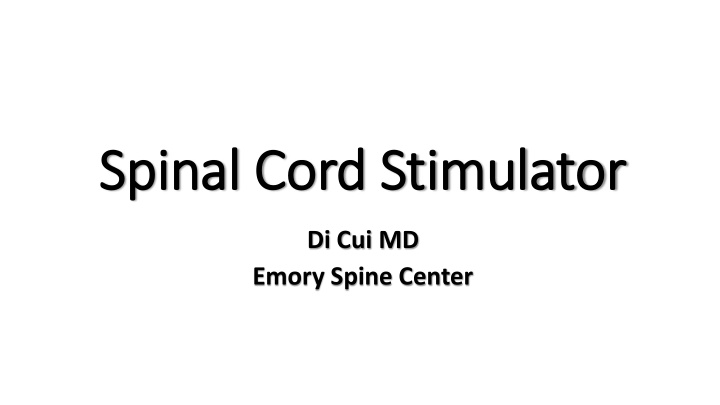



Spi pinal al Co Cord S d Stimul ulator Di Cui MD Emory Spine Center
History and Utilization • First implantation credited to Dr. Norman Shealy in 1967 • Programmable electrodes by medtronics in 1982 • A therapy that alleviates pain by sending electrical stimulation via implanted leads to electrodes in the epidural space • Neurostimulation activates pain-inhibiting neuronal circuits in the dorsal horn and induces a tingling sensation (paresthesia) that masks the sensations of pain.
Indication • Failed back surgery syndrome once other causes are excluded • Multiple sclerosis • Chronic painful peripheral neuropathy or plexopathy • Complex Regional Pain syndrome • Off Label use for Peripheral vascular disease • Newer High Frequency SCS also provide an alternative for axial low back pain
The Mechanism • Segmental, antidromic activation of A- Beta afferents • Gate control theory proposed by Melzack and Wall in 1965 • Blocking of transmission in the spinothalamic tract • Activation of central inhibitory mechanisms influencing sympathetic efferent neurons
The Mechanism
Surgical leads vs Percutaneous leads Percutaneous Leads Surgical Leads May reduce patients’ insertion-related More invasive than percutaneous, thus may discomfort 2 cause patient discomfort 1 May improve implanters’ ability to obtain May have less chance of migration after accurate results during trialing 2 encapsulation due to their shape 1 Offer longitudinal access to multiple levels of the spine 2 A small amount of silicone elastomer adhesive between the inner surface of the anchoring sleeve and the outer surface of the lead may reduce lead migration 2 1. North RB et al. Neurosurgery . 2005;57:990-996. 2. Renard V-M, North RB. Neuromodulation . 2006;9:12-13
SCS vs repeated lumbosacral spine surgery • 50 patients selected for re-operation randomized to SCS vs reoperation, 45 available for follow up @ 3 years • 19 randomized into SCS and 26 for reoperation • 9/19 in the SCS group reports satisfaction, 3/26 from the surgical group • SCS group needed less opioids Neurosurgery. 2005; 56 (1): 98-106
SCS vs medical management: 24 month follow up • 100 patient with failed back surgery • Randomized to SCS vs conventional medical management (CMM) • Favorable results at 6 month • At 24 months, 17/46 randomized SCS group reports >50% relief • At 24 months, 1/41 randomized CMM group reports > 50% relief • 34/72 patient who received SCS as final treatment reports >50% pain relief vs 1/15 for CMM Neurosurgery , Volume 63, Issue 4, 1 October 2008, Pages 762–770
High Frequency vs traditional • 11 centers, 198 patient randomized, 171 implantation • Randomized into traditional SCS vs HF SCS 24 months Back pain relief >50% Leg pain relief >50% Traditional 76.5% 49.3% HF 72.9% 49.3% Neurosurgery. 2016 Nov; 79(5): 667–677.
Complications and disadvantages • Dural Puncture • Estimated to be between 0-0.3% • Infection • 5180 cases reviewed, mean 4.89% (range 2.5-10%) • Lead Fractures/ malfunction • 4602 cases reviewed, mean 6.37% (range 0-10.2%) • Lead migration w/ change or loss of stimulation+ • 4968 cases reviewed, mean 15.49% (range 2.1-27%) Pain Medicine , Volume 17, Issue 2, 1 February 2016, Pages 325–336, Pain Pract. 2011;11(2):148-53.
Where does SCS injection stand? Safety Low High Low High Cost Efficacy Low High Ease of Admin Low High Availability Low High
Thank You
More recommend